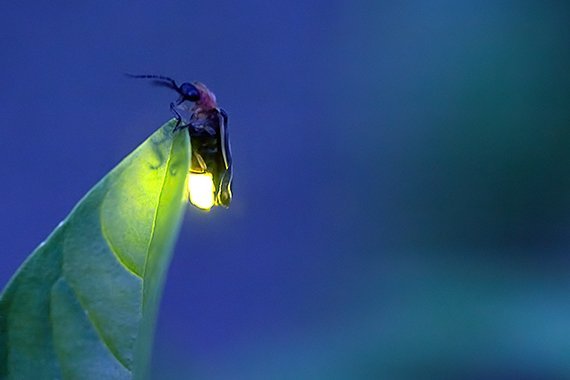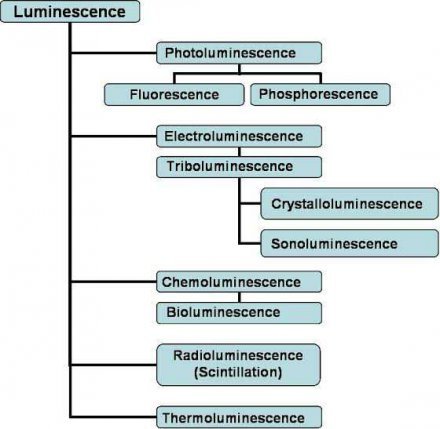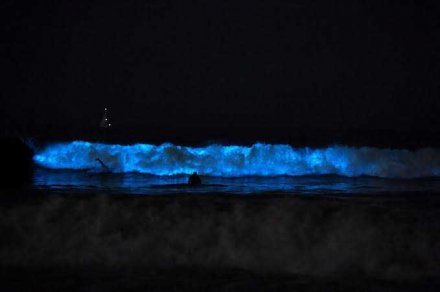During intense heat. In the evening. No electricity. Guy's underwear also looks as warm as a sweater. Annoyed, he came out to the back of the house. The place has become like a bush on the leaves of a tree. In the meanwhile, a light from the team took away your vision; Not really one - hundreds. In the light of the firefly, it seems that the stars of the sky have come down to the forest.
Congratulations! The simplest lesson in bioluminescence you just got right before your eyes.
At the heart of this context is bioluminescence, bioavailability in Bengal. What is bioluminescence? Bioluminescence is the process of producing and eventually emitting light of various colors from living organisms. This is a biological phenomenon.Organisms like fireflies that have this ability are called bioluminescents. Usually we see fireflies as bioluminescents, but the number of such glowing creatures is not small at all! Apart from plants and mammals, many insects, bacteria, fungi, algae, plankton and numerous marine fish have the ability to make light through bioluminescence.Squid, dragonfish, anglerfish, octopus, jellyfish, click beetle, dinoflagelitis ... these cannot be over named. Surprisingly, it is more numerous in marine life. About 7% of marine animals are bioluminescent and live at all levels of the ocean!
Bioluminescence is practically a biochemical phenomenon. Before saying this, it is good to mention that luminescence in nature is not just a kind of chemomluminescence, but bioluminescence itself is not a fundamental part of it.
What is chemiluminescence? When light is emitted in any kind of chemical process, it is called chemiluminescence.
And the chemiluminescence that occurs in the biological (organic + chemical) reaction in an organism is called bioluminescence. Now you can say, do bioluminescence have siblings anymore? Yes, there is! Not only your siblings, there are also many ‘tuto’ siblings. When light is emitted in an electrochemical reaction, it is called electroluminescence. When light is emitted from the dissolution of a radioactive substance, it is called lyoluminescence. These include chemiluminescence.
Also, light absorbed from an external source may be emitted (fluorescence), light may be emitted during crystallization (crystalloluminescence), and even light may be emitted during crystal breakage (factroluminescence). Needless to say, they are all unique in their luminous properties.
Let's go back to bioluminescence. If you don't know how the matter works, is the scientific mind satisfied?
As mentioned earlier, bioluminescence is caused by a chemical reaction inside an organism (evolving over a long period of time). Naturally this reaction will cause light scattering. In reaction, when a protein (or an ion in some species) breaks down a light-producing element, light is emitted as a by-product.
The element that makes light is usually called luciferin (the compound that produces light) and the enzyme that acts here is called luciferge.Luciferin is synthesized from a chemical compound called hispidin. Luciferin is produced by the action of the enzyme hydroxylase on hispidine. This process occurs spontaneously in the bodies of bioluminescents. Let's describe the general technique of emitting light from luciferin here.
Luciferin first forms an intermediate compound called luciferil adenylate by the action of the enzyme. The cellular ATP provides the activation energy (energy that is needed to start the reaction initially) in the reaction. The resulting luciferil adenolate is oxidized by oxygen and produces excited oxyluciferin by periodically releasing carbon dioxide.Oxylucifarin induces keto-inl totom equilibrium. Needless to say, tattoomers are special types of isotopes, or twins of a chemical compound, that look exactly like each other, but have different properties. Excited oxyluciferin radiates energy to come to a stable state, we see the radiated energy as light.We see that our domestic electric light can convert only ten percent of its energy into light energy, the remaining about ninety percent is converted into heat. Interestingly, because luciferin is heat resistant, it keeps light cool, so that bioluminescent organisms do not emit heat, and they can convert 100% of all their energy into light.
The light came out, but what will be its color? From spectroscopy we know that color is actually nothing but waves of a certain wavelength range. There is no single technique for explaining the color of light, but there are many complementary techniques. However, there is not much disagreement about the fact that the structural properties of luciferin largely determine this.In one technique, the nature of the light depends on whether the product compound is coming from the keto compound to the ground state, or from the inl compound to the ground state. Here it is said that keto compounds give red light when excited, and yellowish green light comes from inl compounds. Some strategies emphasize the surrounding environmental factors. It is said that the static electrical response of oxylucifarin to some of the ancillary substances in the environment determines the nature of light by affecting its totomization.
However, the luciferin-luciferge reaction is not the only method of emitting light. Some marine animals use photoproteins called aquarin instead of luciferase. Cilantramide is formed by the reaction of aquarium, another protein, calcium ions and oxygen. The cilantramide produced by the reaction emits blue light.
Some animals, however, have the ability to emit light in addition to the ability to produce light. How? Through symbiosis or symbiosis! These animals may allow bioluminescent bacteria or fungi to live as parasites or provide food - in return they use their 'light'!



